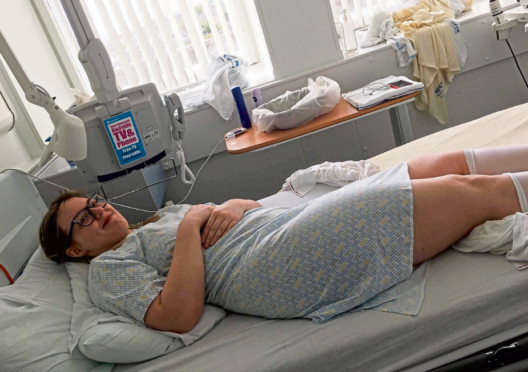A north woman is raising awareness of a rare syndrome after she narrowly avoided becoming paralysed.
Rachel Fairclough, 20, was rushed to Aberdeen Royal Infirmary last Wednesday for emergency back surgery.
She’d had pain in her legs for weeks, but it was thought it was a hamstrig injury caused by her power-lifting hobby and personal trainer work at Gym 300 in Inverness.
Miss Fairclough, from Tain in Ross-shire, said: “The pain started becoming more severe. One day my whole leg lost sensation and became very heavy with a burning pain. It was very distressing.”
Things became so bad she was referred for a scan at Raigmore Hospital.
She explained: “I was seen by Dr Gordon at Tain Healthcare centre, who immediately requested an MRI at Raigmore.”
After the scan, she was given the shock news that she was suffering from Cauda Equina Syndrome (CES).
CES is a condition which occurs when nerves at the base of the spinal cord are squeezed together.
By the time someone with CES cannot empty their bladder, which happened to Miss Fairclough at hospital, they have only 48 hours to undergo spinal surgery. After the two-day period, the chances of irreversible nerve damage can lead to complete paralysis in the waist down.
Miss Fairclough was referred to Aberdeen Royal Infirmary for emergency back surgery. After being discharged on Thursday she is making a positive recovery according to physios.
And now, she wants to make sure that other people don’t go through the same ordeal.
Miss Fairclough, who currently lives in Tain, said: “If people were more aware of how dangerous it can be there would be many more people coming in sooner for treatment and much more could be done.
“Please look up the syndrome and if you have those symptoms, please don’t ignore it.
“It saved my life going to the GP. It was due to Dr Gordon’s willingness to accept and diagnose correctly that could have saved me from paralysis.
“After surgery I feel like I have a new lease of life and I can’t wait to get better and be back working.”
When she is back to full strength, Miss Fairclough plans to start fundraising for the hospital ward she was treated in.
Cauda equina syndrome
Cauda equina syndrome (CES) is a rare disorder that causes pressure on the nerves at the very bottom of the spinal cord.
Only about 1 in 70,000 people are affected each year.
The causes can range significantly, with spinal tumours, inflammatory conditions and trauma injuries all reported to have led to CES.
Due to the uncertainty of a direct cause, sufferers like Rachel Fairclough are urging people to become aware of the disorder’s symptoms.
These include lower back pain, bowel and bladder disturbances, muscle weakness and loss of sensations in the lower parts of the body.
If patients with cauda equina syndrome do not receive treatment quickly, adverse results can include paralysis and other neurological and physical problems.
Visit www.spine-health.com to find out more.
